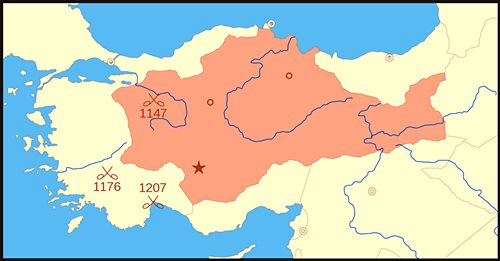
Battle of Hyelion and Leimocheir |
year: 1177 |
| A destruction in ambush of a large raiding Seljuk force by the Byzantines | ★ ★ ★ ★ ★ |
|
enemy: Seljuk Turks
|
location: On a bridge on the Meander river, probably in the general vicinity of Antioch-on-the-Meander (a few km southeast of Kuyucak, Aydin Province, Turkey)
|
accuracy:
●●●●●
|
|
battle type: Ambush |
war: Seljuk Wars |
modern country:
Turkey |
| ▼ The Byzantines(emperor: Manuel I Komnenos) | ▼ The Enemies | |
| Commander: | John Vatatzes | Unknown |
| Forces: | Unknown | 20,000 to 24,000 |
| Losses: | Almost all killed |
| Background story: |
| Following Emperor Manuel Komnenos’ defeat at the Battle of Myriokephalon (1176) the Byzantines failed to implement all the conditions, particularly the destruction of border fortresses, demanded by the Seljuk sultan Kilij Arslan II as a prerequisite for a cessation of hostilities. A substantial Seljuk cavalry army, including Turcoman nomad auxiliaries, was dispatched into Byzantine territory, in the Meander Valley in western Anatolia, on a retaliatory raid. A Byzantine army under the general John Vatatzes, the emperor's nephew, set out from Constantinople with instructions to intercept the Seljuk raiders. Vatatzes was able to pick up reinforcements, under Constantine Doukas and Michael Aspietes, as his army moved through Byzantine territory to meet the invaders. |
The Battle: |
 The Seljuk sultanate of Rum in 12th cent. The Seljuk army was returning towards Turkish territory when it approached a choke point in its journey where the great eastern highway crossed the Meander River by way of a bridge (probably ruined or semi-derelict), near the villages, or forts, of Hyelion and Leimocheir. The Byzantines had concealed themselves and were divided into two corps, separated by the river. They caught the Seljuk army in an ambush when it had partially crossed over the river, destroying it as a fighting force. The Byzantine light troops played a prominent role in the battle; posted on high ground they are described as raining missiles down onto the near helpless Seljuks. Many of the Seljuk soldiers died in the river and only a few out of many thousands were able to survive. The Seljuk commander, bearing the title Atabeg, tried to break out of the trap with his heavily armed retainers but was killed. On the Byzantine side, the general Michael Aspietes fell; he was drowned in the Meander when thrown by his wounded horse. |
Aftermath: |
| The battle underlined how limited were the real effects of the Byzantine defeat at Myriokephalon on the empire's hold over its Anatolian possessions. Byzantium was still strong. |
|
|
